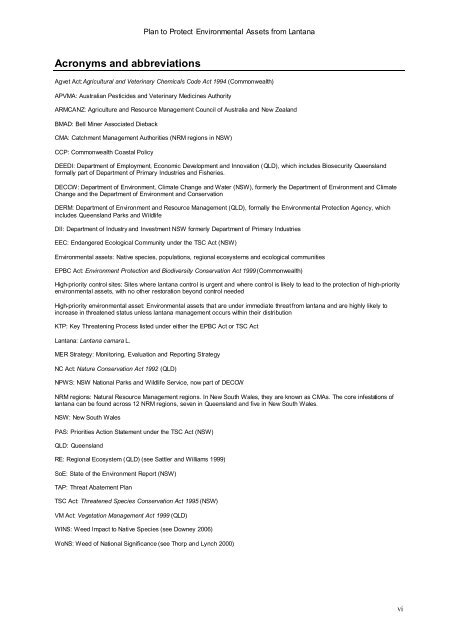Plan to Protect Environmental Assets from Lantana - Weeds Australia
Plan to Protect Environmental Assets from Lantana - Weeds Australia
Plan to Protect Environmental Assets from Lantana - Weeds Australia
Create successful ePaper yourself
Turn your PDF publications into a flip-book with our unique Google optimized e-Paper software.
<strong>Plan</strong> <strong>to</strong> <strong>Protect</strong> <strong>Environmental</strong> <strong>Assets</strong> <strong>from</strong> <strong>Lantana</strong><br />
Acronyms and abbreviations<br />
Agvet Act:Agricultural and Veterinary Chemicals Code Act 1994 (Commonwealth)<br />
APVMA: <strong>Australia</strong>n Pesticides and Veterinary Medicines Authority<br />
ARMCANZ: Agriculture and Resource Management Council of <strong>Australia</strong> and New Zealand<br />
BMAD: Bell Miner Associated Dieback<br />
CMA: Catchment Management Authorities (NRM regions in NSW)<br />
CCP: Commonwealth Coastal Policy<br />
DEEDI: Department of Employment, Economic Development and Innovation (QLD), which includes Biosecurity Queensland<br />
formally part of Department of Primary Industries and Fisheries.<br />
DECCW: Department of Environment, Climate Change and Water (NSW), formerly the Department of Environment and Climate<br />
Change and the Department of Environment and Conservation<br />
DERM: Department of Environment and Resource Management (QLD), formally the <strong>Environmental</strong> <strong>Protect</strong>ion Agency, which<br />
includes Queensland Parks and Wildlife<br />
DII: Department of Industry and Investment NSW formerly Department of Primary Industries<br />
EEC: Endangered Ecological Community under the TSC Act (NSW)<br />
<strong>Environmental</strong> assets: Native species, populations, regional ecosystems and ecological communities<br />
EPBC Act: Environment <strong>Protect</strong>ion and Biodiversity Conservation Act 1999 (Commonwealth)<br />
High-priority control sites: Sites where lantana control is urgent and where control is likely <strong>to</strong> lead <strong>to</strong> the protection of high-priority<br />
environmental assets, with no other res<strong>to</strong>ration beyond control needed<br />
High-priority environmental asset: <strong>Environmental</strong> assets that are under immediate threat<strong>from</strong> lantana and are highly likely <strong>to</strong><br />
increase in threatened status unless lantana management occurs within their distribution<br />
KTP: Key Threatening Process listed under either the EPBC Act or TSC Act<br />
<strong>Lantana</strong>: <strong>Lantana</strong> camara L.<br />
MER Strategy: Moni<strong>to</strong>ring, Evaluation and Reporting Strategy<br />
NC Act: Nature Conservation Act 1992 (QLD)<br />
NPWS: NSW National Parks and Wildlife Service, now part of DECCW<br />
NRM regions: Natural Resource Management regions. In New South Wales, they are known as CMAs. The core infestations of<br />
lantana can be found across 12 NRM regions, seven in Queensland and five in New South Wales.<br />
NSW: New South Wales<br />
PAS: Priorities Action Statement under the TSC Act (NSW)<br />
QLD: Queensland<br />
RE: Regional Ecosystem (QLD) (see Sattler and Williams 1999)<br />
SoE: State of the Environment Report (NSW)<br />
TAP: Threat Abatement <strong>Plan</strong><br />
TSC Act: Threatened Species Conservation Act 1995 (NSW)<br />
VM Act: Vegetation Management Act 1999 (QLD)<br />
WINS: Weed Impact <strong>to</strong> Native Species (see Downey 2006)<br />
WoNS: Weed of National Significance (see Thorp and Lynch 2000)<br />
vi

















